
When Canopus anciently pulled down the 'spirit
aqueduct' causing a dried out 'lake', then the ship
Argo Navis could have gone down too, all the way down to rock bottom far in
the south at Canopus. Noah is looking out in this
imaginative illustration and right down below him at bottom is the great
rishi star (Agastya, Eridu, Canopus).
The power of Canopus was gravity and gravity
pulls down next to everything - except flames from a fire.
... In the
inscriptions of Dendera, published by Dümichen, the goddess
Hathor is called 'lady of every joy'. For once, Dümichen
adds: Literally ... 'the lady of every heart circuit'. This is
not to say that the Egyptians had discovered the circulation of
the blood. But the determinative sign for 'heart' often figures
as the plumb bob at the end of a plumb line coming from a
well-known astronomical or surveying device, the merkhet.
Evidently, 'heart' is something very specific, as it were the
'center of gravity' ... See Aeg.Wb. 2, pp. 55f. for sign of the
heart (ib) as expressing generally 'the middle, the
center'.
And this may lead
in quite another direction. The Arabs preserved a name for
Canopus - besides calling the star Kalb at-tai-man
('heart of the south') ... Suhail el-wezn, 'Canopus
Ponderosus', the heavy-weighing Canopus, a name promptly
declared meaningless by the experts, but which could well have
belonged to an archaic system in which Canopus was the weight at
the end of the plumb line, as befitted its important position as
a heavy star at the South Pole of the 'waters below' ...

The 'winter-summer' (toga-hora) glyphs are
ending at
φ Gemini 4 * 29½ days from 0h.
There are no more such in the text, neither on side a nor on
side b, and counted from Ga1-6 (the left part of which belongs
in the group) to the last specimen there were 48 days.
 |
 |
 |
 |
 |
19 |
|
Ga1-30 |
Ga2-1 |
Ga2-2 |
Ga2-3 (33) |
Ga2-4 |
|
Furud
(94.9) |
Well-22 |
no star
listed (96) |
β
Monocerotis, ν Gemini (97.0) |
no star
listed (98) |
|
δ Columbae
(95.2),
TEJAT
POSTERIOR,
Mirzam (95.4), CANOPUS (95.6), ε Monocerotis (95.7), ψ1
Aurigae (95.9) |
|
June 23 |
ST JOHN'S
EVE |
25 |
26 (177) |
27 |
|
ºJune 19 |
20 (*91) |
SOLSTICE |
22 |
23 |
|
'May 27 |
28 (*68) |
29 |
30 (*70) |
31 |
|
'Vaitu Potu
27 |
28 (148) |
29 |
30 (150) |
31 |
|
"May 13 |
14 (*54) |
15 (*55) |
16 (136) |
17 |
|
Purva
Ashadha-20 |
Kaus Borealis (279.3) |
ν Pavonis (280.4), κ Cor.
Austr. (280.9) |
Abhijit-22 |
|
KAUS
MEDIUS, κ Lyrae (277.5), Tung Hae (277.7) |
KAUS
AUSTRALIS (278.3), ξ Pavonis (278.4), Al Athfar
(278.6) |
θ Cor. Austr. (281.0),
VEGA (281.8) |
|
December 23
(357) |
CHRISTMAS
EVE |
25 |
26 (360) |
27 |
|
ºDec 19
(*273) |
20 |
SOLSTICE |
22 |
23 (357) |
|
'November 26
(*250) |
27 |
28 |
29 |
30 (*254) |
|
'Ko Ruti 26 |
27 |
28 |
29 (333) |
30 |
|
"November 12
(*236) |
13 |
14 |
15 |
16 (320) |
 |
 |
 |
 |
 |
 |
 |
|
Ga2-24 |
Ga2-25 |
Ga2-26 |
Ga2-27 |
Ga2-28 |
Ga2-29 |
Ga3-1 (60) |
|
φ Gemini (118.4) |
Drus (119.9) |
ω Cancri (120.2) |
8h (121.7) |
ρ Puppis (122.0), Heap
of Fuel (122.1), ζ Monocerotis
(122.3), ψ Cancri (122.6),
Regor (122.7) |
Tegmine (123.3) |
Al Tarf (124.3)
Ras
Algethi
|
|
χ Gemini (121.0),
Naos (121.3) |
|
July 17 |
18 |
19 (200) |
20 |
21 |
22 |
23 |
|
ºJuly 13 |
14 |
15 (*116) |
16 |
17 |
18 |
19 (200) |
|
'June
20 (*91) |
SOLSTICE |
22 |
23 |
ST JOHN'S EVE |
25 |
26 |
|
'He Maro
20 |
SOLSTICE |
22 |
23 |
ST JOHN'S EVE |
25 |
26 (177) |
|
"June
6 |
7 (*78) |
8 |
9 (160) |
10 |
11 |
12 |
|
ι
Sagittarii (301.2), Terebellum, ξ
Aquilae (301.3),
Alshain
(301.6), φ Aquilae (301.8) |
ε
Pavonis, θ Sagittarii (302.3), γ
Sagittae (302.5), μ Pavonis (302.7) |
τ
Aquilae (303.8) |
20h (304.4) |
Shang
Wei (305.2), θ Sagittae (305.4),
Tseen Foo (305.6), ξ Capricorni
(305.8) |
Tso Ke
(306.3) |
Gredi
(307.2), σ Capricorni (307.5),
Alshat (307.9) |
|
η
Sagittae (304.2), δ Pavonis (304.4) |
|
January
16 |
17 |
18 (383) |
19 |
20 |
21 |
22 |
|
ºJanuary
12 |
13 (378) |
14 |
15 (*300) |
16 |
17 |
18 |
|
'December
20 |
SOLSTICE |
22 |
23 (*277) |
CHRISTMAS EVE |
25 |
26 |
|
'Ko Koró
20 |
SOLSTICE |
22 |
23 |
CHRISTMAS EVE |
25 |
26 (360) |
|
"December 6 |
7 |
8 |
9 |
10 (*264) |
11 |
12 (346) |
 |
 |
 |
 |
 |
|
Ga1-6 |
Ga2-2 |
Ga2-4 |
Ga2-6 |
Ga2-8 |
 |
 |
 |
 |
 |
|
Ga2-10 |
Ga2-12 |
Ga2-14 |
Ga2-16 |
Ga2-24 |
|
Egyptian bread, (-t, female
determinant) |
 |
Phoenician qoph |
 |
Greek
phi |
Φ(φ) |
|
... is the
21st letter of the Greek alphabet ... Its
origin is uncertain but it may be that phi
originated as the letter qoppa ... In
traditional Greek numerals, phi has a value
of 500 or 500000 ...
Isaac Taylor, History of the Alphabet:
Semitic Alphabets, Part 1, 2003: 'The
old explanation, which has again been
revived by Halévy, is that it denotes an
'ape,' the character Q being taken to
represent an ape with its tail hanging down.
It may also be referred to a Talmudic root
which would signify an 'aperture' of some
kind, as the 'eye of a needle,' ...
Lenormant adopts the more usual explanation
that the word means a 'knot' ...
... The king, wearing now a short, stiff
archaic mantle, walks in a grave and stately
manner to the sanctuary of the wolf-god
Upwaut, the 'Opener of the Way', where
he anoints the sacred standard and, preceded
by this, marches to the palace chapel, into
which he disappears. A period of time
elapses during which the pharaoh is no
longer manifest.
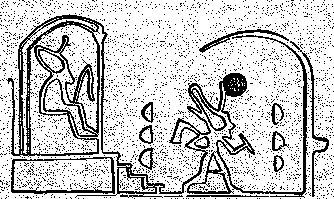
When he reappears he is clothed as in the
Narmer palette, wearing the kilt with
Hathor belt and bull's tail attatched.
In his right hand he holds the flail scepter
and in his left, instead of the usual crook
of the Good Shepherd, an object resembling a
small scroll, called the Will, the House
Document, or Secret of the Two Partners,
which he exhibits in triumph, proclaiming to
all in attendance that it was given him by
his dead father Osiris, in the
presence of the earth-god Geb. 'I
have run', he cries, 'holding the Secret of
the Two Partners, the Will that my father
has given me before Geb. I have
passed through the land and touched the four
sides of it. I traverse it as I desire.' ... |
The last Greek lettered star in Gemini was
χ, which in rongorongo times
was rising with the Sun at 8h together with Naos in Argo
Navis. The Greek letter of Naos is ζ and its location is at the
first of the 7 ropes leading up towards the top of the mast:
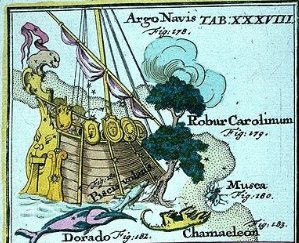
'Plumb lines' (strings) there were both high up
at the reversed Eagle (Lyra) and in the right hand of Castor:
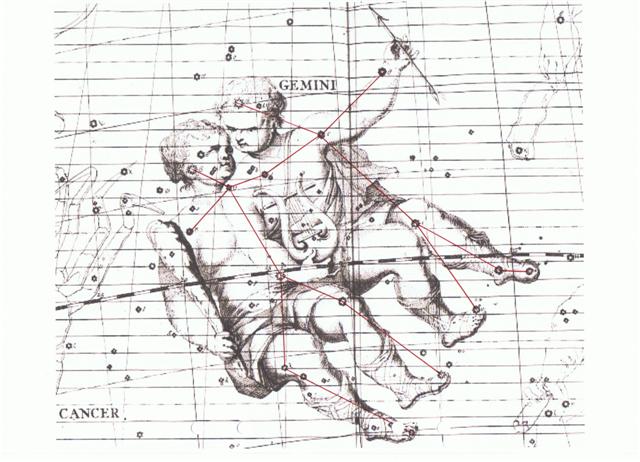
Castor has both arrow and 'bow' in contrast to
Pollux with his single club. Or the thin arrow of in the left
hand of Castor is in contrast to the thick club in the right
hand of Pollux. Together they illustrate the balance between
water (winter) and air (summer).
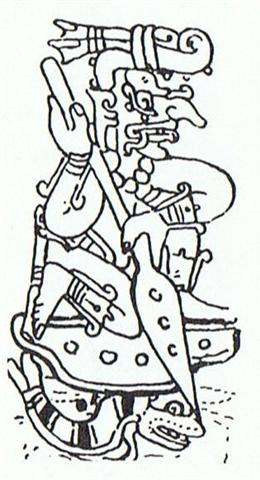 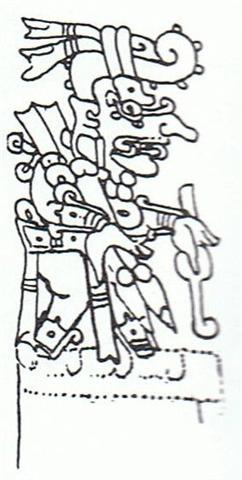

I think the weighing of the heart down in the
Underworld is a misunderstanding. The 'Heart' is balanced
against a 'Feather'. The light bird feathers symbolize air and
the heavy heart symbolizes a bucket of water.

|

















